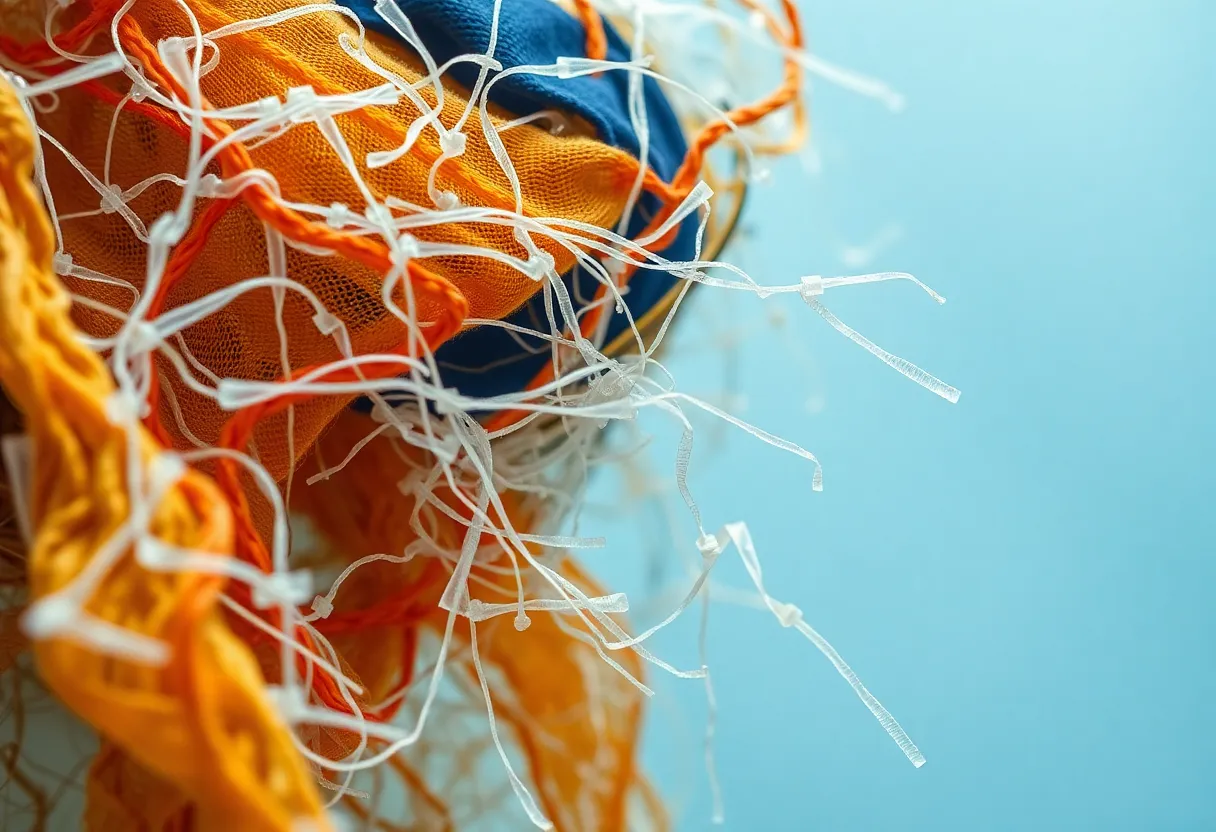Fort Worth, September 27, 2025
News Summary
A TCU senior’s peer-reviewed study reveals connections between synthetic textiles and health risks from microplastic fibers. The research shows how these fibers can enter human organs, emphasizing the need for sustainable practices in the fashion industry. Recommendations include the use of biodegradable finishes and improved filtration systems to mitigate pollution. The study highlights the broader implications for consumer safety and industry standards, as microplastic pollution raises concerns for long-term health impacts.
Fort Worth — A Texas Christian University (TCU) senior’s peer-reviewed research draws direct links between synthetic textiles and potential human health risks from microplastic fibers, highlighting pathways from fiber production to the presence of particles in human organs and calling for sustainable industry responses.
Top lines
TCU senior Adelaide Lovett explored the impact of fashion on health and the environment. Lovett’s study, published in May in the peer-reviewed journal *Textiles*, focused on synthetic fibers and their contribution to microplastic pollution. The study investigates how microplastic fibers can lodge in human organs such as the heart, lungs, and liver.
Key findings and immediate implications
Lovett’s published research identifies multiple stages in the lifecycle of synthetic textiles where microplastic fibers are released into ecosystems, including fiber production, textile finishes, laundering, and disposal. The investigation underscores the potential for microscopic synthetic fibers to enter biological systems and be retained in organs, a pathway that raises concerns for long-term health consequences and that warrants additional toxicological and epidemiological study.
Suggested industry responses
The study outlines potential responses available to manufacturers and policymakers, including biodegradable finishes, improved filtration systems, and circular fashion models for recycling fibers. These approaches are framed as technical and systemic options that could reduce the flow of microplastic fibers into the environment at source and during garment use and end-of-life.
Methodology, mentorship and interdisciplinary context
Lovett conducted the research under the mentorship of Charles Freeman, fashion merchandising chair, and Leslie Browning-Samoni, an instructor. Her work combined knowledge from fashion merchandising and psychology, supported by coursework in neuroscience, creating an interdisciplinary approach intended to connect garment science with human health outcomes and consumer behavior.
Lovett aims to connect fashion with psychology, leveraging her dual focus in fashion merchandising and psychology, along with coursework in neuroscience. She previously collaborated with TCU psychology professor Timothy Barth on research regarding ethical and moral decision-making, reflecting a broader pattern of cross-discipline scholarship.
Recognition and related student work
In June, Lovett contributed to a TCU student team that won the 2025 Best Innovation Award at NASA’s Spaceflight Human Optimization Conference in Houston. The TCU student team’s project involved high-performance materials such as Kevlar and polyurethane-coated fabrics for seam samples tested in simulated moon dust. The team created flexible suit seams designed to protect astronauts from hazardous lunar dust without relying on coatings or tape, and Lovett played a key role in sewing initial test pieces and standardizing details for consistency in data collection during the project.
Institutional alignment and broader context
TCU highlights the importance of interdisciplinary work, aligning with its strategic pillar of Research, Scholarship, and Creative Activities. The university framed Lovett’s investigation as consistent with campus priorities that incentivize student-faculty collaboration and applied scholarship. The study’s emphasis on sustainable practices responds to growing consumer and regulatory pressures for reduced microplastic pollution and safer materials in consumer products.
Why this matters
Addressing environmental and health implications linked to synthetic textiles is presented in the study as crucial for the fashion industry. If microplastic fibers are confirmed to accumulate in human organs, industry stakeholders, regulators, and researchers will need to increase focus on upstream materials choices, manufacturing controls, consumer care instructions, and end-of-life policies to mitigate exposure risks.
Key facts
- Texas Christian University (TCU) senior Adelaide Lovett explored the impact of fashion on health and the environment.
- Lovett’s study, published in May in the peer-reviewed journal *Textiles*, focused on synthetic fibers and their contribution to microplastic pollution.
- The study investigates how microplastic fibers can lodge in human organs such as the heart, lungs, and liver.
- Lovett’s research was conducted under the mentorship of Charles Freeman, fashion merchandising chair, and Leslie Browning-Samoni, an instructor.
- The study outlines how fiber production, textile finishes, laundering, and disposal release particles into ecosystems.
- Lovett aims to connect fashion with psychology, leveraging her dual focus in fashion merchandising and psychology, along with coursework in neuroscience.
- She has previously collaborated with TCU psychology professor Timothy Barth on research regarding ethical and moral decision-making.
- TCU highlights the importance of interdisciplinary work, aligning with its strategic pillar of Research, Scholarship, and Creative Activities.
- Lovett’s investigation highlights the need for sustainable practices in the fashion industry, responding to consumer and regulatory pressures.
- Potential industry responses suggested by the study include biodegradable finishes, improved filtration systems, and circular fashion models for recycling fibers.
- In June, Lovett contributed to a TCU student team that won the 2025 Best Innovation Award at NASA’s Spaceflight Human Optimization Conference in Houston.
- The team created flexible suit seams designed to protect astronauts from hazardous lunar dust without relying on coatings or tape.
- Lovett played a key role in sewing initial test pieces and standardizing details for consistency in data collection during the project.
- The TCU student team’s project involved high-performance materials such as Kevlar and polyurethane-coated fabrics for seam samples tested in simulated moon dust.
- Lovett described the NASA project as a fulfilling achievement in her educational journey, which also included collaborative efforts with faculty advisors.
- The study emphasizes that addressing environmental and health implications linked to synthetic textiles is crucial for the fashion industry.
FAQ
- What did the TCU senior study?
- Texas Christian University (TCU) senior Adelaide Lovett explored the impact of fashion on health and the environment.
- Where was the study published and what did it focus on?
- Lovett’s study, published in May in the peer-reviewed journal *Textiles*, focused on synthetic fibers and their contribution to microplastic pollution.
- What health risks does the study investigate?
- The study investigates how microplastic fibers can lodge in human organs such as the heart, lungs, and liver.
- Who mentored Lovett’s research?
- Lovett’s research was conducted under the mentorship of Charles Freeman, fashion merchandising chair, and Leslie Browning-Samoni, an instructor.
- What lifecycle stages release microplastic particles?
- The study outlines how fiber production, textile finishes, laundering, and disposal release particles into ecosystems.
- Did Lovett receive recognition for other student projects?
- In June, Lovett contributed to a TCU student team that won the 2025 Best Innovation Award at NASA’s Spaceflight Human Optimization Conference in Houston.
| Feature | Detail |
|---|---|
| Researcher | Texas Christian University (TCU) senior Adelaide Lovett explored the impact of fashion on health and the environment. |
| Publication | Lovett’s study, published in May in the peer-reviewed journal *Textiles*, focused on synthetic fibers and their contribution to microplastic pollution. |
| Health concern | The study investigates how microplastic fibers can lodge in human organs such as the heart, lungs, and liver. |
| Lifecycle sources | The study outlines how fiber production, textile finishes, laundering, and disposal release particles into ecosystems. |
| Industry responses | Potential industry responses suggested by the study include biodegradable finishes, improved filtration systems, and circular fashion models for recycling fibers. |
| Related student work | In June, Lovett contributed to a TCU student team that won the 2025 Best Innovation Award at NASA’s Spaceflight Human Optimization Conference in Houston. |
Deeper Dive: News & Info About This Topic
HERE Resources
Additional Resources
- Dallas Innovates: TCU Student Uncovers Fashion’s Hidden Costs and Designs for the Moon
- Wikipedia: Fashion Industry
- Dallas Innovates: Fort Worth Celebrity Chef Tim Love Launches Capsule Apparel Love Collection
- Google Search: Sustainable Fashion
- Dallas Innovates: 100-Year-Old Dickies is Moving into a Stylish New HQ in Downtown Fort Worth
- Google Scholar: Synthetic Textiles Microplastics
- Dallas Innovates: Tribe Alive Empowers Female Artisans in Fashion
- Encyclopedia Britannica: Fashion and Environment
- Dallas Innovates: Dallas Resident Fashions 3D Model of City’s Skyline
- Google News: Microplastics Health Risks

Author: STAFF HERE DALLAS WRITER
The DALLAS STAFF WRITER represents the experienced team at HEREDallas.com, your go-to source for actionable local news and information in Dallas, Dallas County, and beyond. Specializing in "news you can use," we cover essential topics like product reviews for personal and business needs, local business directories, politics, real estate trends, neighborhood insights, and state news affecting the area—with deep expertise drawn from years of dedicated reporting and strong community input, including local press releases and business updates. We deliver top reporting on high-value events such as the State Fair of Texas, Deep Ellum Arts Festival, and Dallas International Film Festival. Our coverage extends to key organizations like the Dallas Regional Chamber and United Way of Metropolitan Dallas, plus leading businesses in telecommunications, aviation, and semiconductors that power the local economy such as AT&T, Southwest Airlines, and Texas Instruments. As part of the broader HERE network, including HEREAustinTX.com, HERECollegeStation.com, HEREHouston.com, and HERESanAntonio.com, we provide comprehensive, credible insights into Texas's dynamic landscape.





